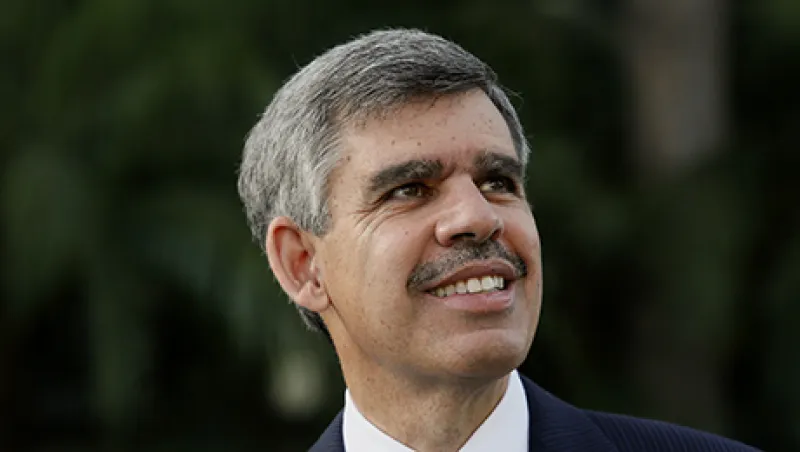When Mohamed El-Erian speaks, the markets listen. And right now El-Erian, one of the world’s leading bond market voices, is saying that the U.S. dollar is going to rise over the near term against the euro and the yen.
“You would expect — and I do expect — that the global standing of the dollar would be more than it would have been otherwise,” El-Erian says in an interview with Institutional Investor. El-Erian, the recently departed CEO and co–chief investment officer at Pacific Investment Management Co., currently works as chief economic adviser for PIMCO’s parent, the big German insurance group Allianz. His comments draw attention to a quiet dollar rally that has already begun in recent weeks, one that he believes is likely to last through year-end and, by some accounts, should continue through next summer.
“Put another way: Investors will get rewarded more by investing in U.S. dollar interest-bearing assets than in the equivalent in Europe or Japan,” says El-Erian. As a result, funds are flowing into the U.S. to purchase dollar-denominated assets. “There’s a very big differential between the ten-year Treasury rate at 2.50 and the ten-year German Bund rate at 1.15 — that historically is a very large gap.”
The interest rate gap could actually widen in the coming months as U.S. monetary policy starts to diverge more from European and Japanese central bank policy. At the peak of its third phase of quantitative easing a year ago, the Fed was purchasing $85 billion in bonds a month — a pace of $1 trillion a year — but it has been tapering its buying since January. “By October the Fed will have exited quantitative easing entirely,” says El-Erian. “It is signaling the likelihood that rates will start rising in the middle of next year. Compare that to the European Central Bank, which is likely to loosen its monetary policy more in September, October — and the Bank of Japan, where monetary policy will remain ultra-loose.”
Although El-Erian is confident about a further rise of the dollar against the euro, he is less certain about the direction the yen will take against the dollar. Unlike the euro zone, he says, Japan has the ability to repatriate capital readily, meaning that the yen’s trajectory is a little more tricky to forecast. Even so, other observers expect the yen to continue to weaken against the dollar. For example, in a note published July 14, Shusuke Yamada, chief forex strategist at Bank of America Merrill Lynch in Tokyo, predicted the yen would weaken to 108 by the end of the year, “driven by the widening U.S.-Japan yield gap.”
The dollar, which traded at $1.39 per euro on May 7, was trading at $1.34 on July 28, and El-Erian expects it to continue to strengthen, to $1.30 by year’s end. He also sees the dollar appreciating in value against the yen. The dollar has recently risen against the yen, from 101.34 yen per dollar on July 18 to 101.82 yen per dollar on July 28, a modest weakening beyond its steep 34 percent slide from its peak of 75.83 yen to the dollar in October 2011.
A second factor underlying the dollar rally is the expectation that “the U.S. economy, while not reaching escape velocity, will remain stronger than both Europe and Japan,” says El-Erian. “The U.S. economy is also benefiting from a significant and positive productivity shock, in the form of the energy revolution.” That is, he points out, one economic boost that neither Europe nor Japan is experiencing.
Other U.S.-based market observers are also starting to talk about a dollar rally. For example, Goldman Sachs Group is forecasting that the dollar will rise 4.3 percent over the coming year against developed and emerging markets, with most of the gain against the most highly developed markets. In a July 17 note titled “The Dollar Bull Case Is Quietly Getting Stronger,” Goldman analysts Robin Brooks and Michael Cahill contend that the widening gap between the two-year Treasury rate relative to the two-year Eurobond rate should have already pushed the dollar higher than it is against the euro. “While rates markets are pricing cyclical outperformance of the U.S., the dollar is not,” Brooks and Cahill write. “We think the dollar has lagged the rate differential because it is more sensitive to Fed rhetoric” about keeping rates low, the authors state. They expect the dollar to rally as the market gives more weight to the rate differential between U.S. and European bonds.
What currencies do have a long-term advantage? According to El-Erian, emerging-markets currencies are something on which to keep an eye for the long term, as they correlate to these economies’ low levels of debt and deficits, as well as high economic growth rates. Whereas a number of emerging-markets currencies have fallen in value against the dollar so far this year, “over the long term, I see the dollar weakening vis-à-vis a basket of emerging-markets currencies,” says El-Erian. He did not want to name specific currencies, however; he did identify four currencies that would be in the basket: the Chinese renminbi, the Brazilian real, the Indian rupee and the South African rand.
Although U.S. interest rates are higher than those in Europe, they are still low by historical standards. El-Erian identifies three factors that are dampening U.S. interest rates. First, the U.S. is already less vulnerable than Europe and Japan to disruptions in oil and gas because of domestic oil shale extraction and fracking activity and is becoming even less so. Second, the Fed is pursuing policies to keep interest rates low. Third, the U.S. economy, although stronger than Europe’s and Japan’s, nevertheless “has undershot growth expectations,” he says.
For years, a rising ratio of debt to the U.S. gross domestic product has kept the dollar weaker against other currencies and prompted such market observers as James Rickards and Steve Forbes to warn that the weak dollar leaves the international monetary system and global economy vulnerable to dire outcomes. Now, with the Congressional Budget Office forecasting the deficit to fall to $492 billion for the 2014 fiscal year, which ends September 30, the debt-to-GDP ratio is temporarily stabilizing, according to El-Erian. “But when people look beyond the next few years and look at the longer-term entitlement issues, people worry the debt will resume an upward path,” he says.
Get more on foreign exchange and on macro.






